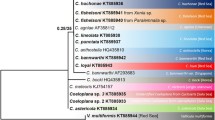Abstract
Genetic variation of the Antarctic anisakid Contracaecum radiatum from the Ross and Weddell Seas is studied at 24 enzyme loci. All polymorphic loci proved to be in Hardy-Weinberg equilibrium, with no significant differences between the samples tested. Several loci were found to be diagnostic between C. radiatum and the five known members of the C. osculatum complex, indicating that no gene exchange occurs between them and confirming their specific status. No F1 hybrids, recombinant or introgressed individuals, sharing radiatum and osculatum alleles, were detected in the Antarctic Contracaecum samples; this directly proves the reproductive isolation of C. radiatum. Biochemical keys are given for the identification of Antarctic C. radiatum, C. osculatum D and E, both for adults (males and females) and larvae. Higher values of genetic variability were observed in these Antarctic Contracaecum species than in the Arctic-Boreal C. osculatum members, possibly related to a lower degree of habitat disturbance (i.e. by pollution, fishing and hunting) in the Antarctic region. On the basis of genetic distances, the evolutionary divergence between C. radiatum and C. osculatum (sensu lato) started about 5 million years ago, possibly with the first colonisation of the Antarctic region by seals. Data on paratenic (fish) and definitive (seal) hosts of C. radiatum and C. osculatum D and E are given.
Similar content being viewed by others
References
Baylis H.A. (1937) On the ascarids parasitic in seals, with special reference to the genus Contracaecum. Parasitology, 29, 121–130.
Beverley-Burton M. (1971) Helminths from the Weddell seal, Leptonychotes weddelli (Lesson, 1926), in the Antarctic. Canadian Journal of Zoology, 49, 75–83.
Dailey M.D. & Brownell R.L. Jr (1972) A checklist of marine mammal parasites. In: Ridgeway S.H. (Ed.) Mammals of the sea. Springfield, Illinois: Charles C. Thomas, pp. 528–589.
Dailey, M.D. (1975) The distribution and interspecific variation of helminth parasites in pinnipeds (proceedings of a Symposium on the Biology of Seals, 14–17 August 1972). Rapports et Procés-Verbaux des Réunions, Conseil International pour l'Exploration de la Mer, p. 169.
Elston R.C. & Forthofer R. (1977) Testing for Hardy-Weinberg equilibrium in small samples. Biometrics, 33, 536–542.
Fagerholm H.-P. (1988) Patterns of caudal papillae in Contracaecum osculatum (Nematoda) and some related species from different regions of the world. International Journal for Parasitology, 18, 1039–1051.
Fagerholm H.-P. (1989) Intra-specific variability of the morphology in a single population of the seal parasite Contracaecum osculatum (Rudolphi) (Nematoda, Ascaridoidea), with a redescription of the species. Zoologica Scripta, 16, 19–24.
Feltz E.T. (1967) Evidence of regurgitation of nematodes by a Weddell seal, Leptonychotes weddelli (Lesson 1826) at McMurdo Sound, Antarctica. Säugetierkundliche Mitteilungen, 15, 55–57.
Haldane J.B. (1954) An exact test for randomness of mating. Journal of Genetics, 52, 631–635.
Johnston T.H. & Mawson P.M. (1945) Parasitic nematodes. Report of the British, Australian and New Zealand Antarctic Research Expedition 1929–1931, ser B, 5, 73–159.
Klöser H. & Plötz J. (1992) Morphological distinction between adult Contracaecum osculatum and Contracaecum radiatum (Nematoda, Anisakidae) from the Weddell Seal (Leptonychotes weddelli). Zoologica Scripta, 21, 129–132.
Klöser H., Plötz J., Palm H., Bartsch A. & Hubold G. (1992) Adjustment of anisakid nematode life cycles to the high Antarctic food web as shown by Contracaecum radiatum and C. osculatum in the Weddell Sea. Antarctic Science, 4, 171–178.
Kohen R.K. & Eanes W.F. (1978) Molecular structure and protein variation within and among populations. Evolutionary Biology, 11, 39–100.
Markowski S. (1971) On some species of parasitic worms in the ‘Discovery’-collections obtained in the years 1925–1926. Bulletin of the British Museum (Natural History) [Zoology], 21, 51–65.
Nascetti G., Bullini L., Cianchi R., Paggi L., Orecchia P., Mattiucci S., D'Amelio S. & Berland B. (1990) Genetic relationships among Anisakid species belonging to the genera Contracaecum and Phocascaris. Proceedings of ICOPA VII, Paris. Bulletin de la Société Française de Parasitologie, 8(suppl. 1), p. 261.
Nascetti G., Cianchi R., Mattiucci S., D'Amelio S., Orecchia P., Paggi L., Brattey J., Berland B., Smith J.W. & Bullini L. (1993) Three sibling species within Contracaecum osculatum (Nematoda, Ascaridida, Ascaridoidea) from the Atlantic Arctic Boreal region: reproductive isolation and host preferences. International Journal for Parasitology, 23, 105–120.
Nei M. (1972) Genetic distance between populations. The American Naturalist, 106, 283–292.
Nei M. (1975) Molecular population genetics and evolution. Amsterdam: North Holland, 288 pp.
Orecchia P., Berland B., Paggi L., Nascetti G., Mattiucci S. & Bullini L. (1986) Divergenza genetica di specie dei generi Contracaecum e Phocascaris (Ascaridida, Anisakidae) con diverso ciclo biologico. Annali Istituto Superiore di Sanitá, 22, 345–348.
Orecchia, P., Mattiucci, S., D'Amelio, S., Paggi, L., Plötz, J., Cianchi, R., Nascetti, G., Arduino, P. & Bullini, L. (In press) Two new members in the Contracaecum osculatum complex (Nematoda, Ascaridoidea) from the Antarctic. International Journal for Parasitology.
Prévost J. (1964) Observations complementaires sur les pinnipedes de l'Archipel de Pointe Geologie. Mammalia, 28, 351–358.
Rogers, J.S. (1972) Measures of genetic similarities and genetic distance, Studies in Genetics VII. University of Texas Publications No. 7213, 145–153.
Sneath P.H.A. & Sokal R.R. (1973) Numerical taxonomy. San Francisco: W.H. Freeman and Co., 573 pp.
Sokal R.R. & Rholf F.J. (1981). Biometry. (2nd Edition). San Francisco: W.H. Freeman & Co. 859 pp.
Wilkinson L. & Leland J. (1989) SYSTAT: The system for Statistics. Evanson, Illinois: SYSTAT Inc.
Author information
Authors and Affiliations
Rights and permissions
About this article
Cite this article
Arduino, P., Nascetti, G., Cianchi, R. et al. Isozyme variation and taxonomic rank of Contracaecum radiatum (v. Linstow, 1907) from the Antarctic Ocean (Nematoda, Ascaridoidea). Syst Parasitol 30, 1–9 (1995). https://doi.org/10.1007/BF00009238
Accepted:
Issue Date:
DOI: https://doi.org/10.1007/BF00009238




